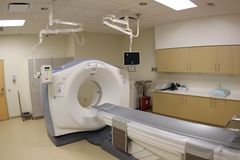CT Scans
Top Contributors - Samuel Adedigba, Mande Jooste, Lucinda hampton, Admin, Rachael Lowe, Naomi O'Reilly, Karen Wilson and Kim Jackson
Computed Tomography[edit | edit source]
Computed tomography (CT) is an imaging procedure that uses special x-ray equipment to create detailed pictures, or scans, of areas inside the body. It is also called computerized tomography and computerized axial tomography (CAT). The term tomography comes from the Greek words tomos (a cut, a slice, or a section) and graphein (to write or record).[1] Computed tomography (CT) is noninvasive and produces cross-sectional images of the body. Each cross-sectional image represents a “slice” of the person being imaged, like the slices in a loaf of bread. These cross-sectional images are used for a variety of diagnostic and therapeutic purposes.[2]
CT scans can be performed on every region of the body for a variety of reasons (e.g., diagnostic, treatment planning, interventional, or screening). Most CT scans are performed as outpatient procedures. Computed tomography was originally known as the "EMI scan" as it was developed at a research branch of EMI, a company best known today for its music and recording business. It was later known as computed axial tomography (CAT or CT scan) and body section röntgenography.
The cross-sectional images generated during a CT scan can be reformatted in multiple planes, and can even generate three-dimensional images which can be viewed on a computer monitor, printed on film or transferred to electronic media.[3]
Although most common in medicine, CT is also used in other fields, such as nondestructive materials testing. Another example is the DigiMorph project at the University of Texas at Austin which uses a CT scanner to study biological and paleontological specimens.
Purpose[edit | edit source]
CT-scans provide detailed cross-sectional images of various internal structures for example internal organs, blood vessels, bones, soft tissue etc, and can be used for:
- Diagnostic purposes-
- Guidance for specific treatment or further tests- surgeries, biopsies and radiation therapy
- Detection and monitoring of conditions- Cancer, heart disease, lung nodules, liver masses
Indications for CT Scans:
- Traumatic injuries
- Degenerative conditions, such as stenosis and osteoarthritis when an MRI is contraindicated
- Post-operative conditions
- Neoplastic conditions
- Infectious processes
- Image guidance during injections, biopsy’s and aspirations
- Abnormalities of bony alignment, such as scoliosis
- Processes involving the spinal cord when MRI is contraindicated[4]
Technique[edit | edit source]
Most modern CT machines take continuous pictures in a helical (or spiral) fashion rather than taking a series of pictures of individual slices of the body, as the original CT machines did. Helical CT has several advantages over older CT techniques: it is faster, produces better 3-D pictures of areas inside the body, and may detect small abnormalities better. The newest CT scanners, called multislice CT or multidetector CT scanners, allow more slices to be imaged in a shorter period of time.[1]
Digital geometry processing is used to generate a three-dimensional image of the inside of an object from a large series of two-dimensional X-ray images taken around a single axis of rotation. CT produces a volume of data which can be manipulated, through a process known as "windowing", in order to demonstrate various bodily structures based on their ability to block the X-ray/Röntgen beam. Although historically the images generated were in the axial or transverse plane, orthogonal to the long axis of the body, modern scanners allow this volume of data to be reformatted in various planes or even as volumetric (3D) representations of structures.
Sometimes, CT involves the use of a contrast (imaging) agent, or “dye.” The dye may be given by mouth, injected into a vein, given by enema, or given in all three ways before the procedure. The contrast dye highlights specific areas inside the body, resulting in clearer pictures. Iodine and barium are two dyes commonly used in CT[1]
Procedure[2][edit | edit source]
- A motorized table moves the patient through a circular opening in the CT imaging system.
- While the patient is inside the opening, an X-ray source and a detector assembly within the system rotate around the patient. A single rotation typically takes a second or less. During rotation the X-ray source produces a narrow, fan-shaped beam of X-rays that passes through a section of the patient's body.
- Detectors in rows opposite the X-ray source register the X-rays that pass through the patient's body as a snapshot in the process of creating an image. Many different "snapshots" (at many angles through the patient) are collected during one complete rotation.
- For each rotation of the X-ray source and detector assembly, the image data are sent to a computer to reconstruct all of the individual "snapshots" into one or multiple cross-sectional images (slices) of the internal organs and tissues.
Resources[edit | edit source]
References[edit | edit source]
- ↑ 1.0 1.1 1.2 National Cancer Institute. Computed Tomography (CT) Scans and Cancer [Internet]. 2013 [cited 30/04/2019]. Available from: https://www.cancer.gov/about-cancer/diagnosis-staging/ct-scans-fact-sheet.
- ↑ 2.0 2.1 U.S Food and Drug Administration. Computed Tomography (CT) [Internet]. 03/06/2018 [cited 30/04/2019]. Available from: https://www.fda.gov/radiation-emitting-products/medical-x-ray-imaging/computed-tomography-ct
- ↑ Radiologyinfo.org. Computed Tomography [Internet]. 2019 [cited 30/04/2019]. Available from: https://www.radiologyinfo.org/en/submenu.cfm?pg=ctscan
- ↑ College, A. ACR – ASNR – ASSR – SPR PRACTICE GUIDELINE FOR THE PERFORMANCE OF COMPUTED TOMOGRAPHY ( CT ) OF THE SPINE. Diagnostic Imaging, 1-7. 2011
- ↑ The National Institute of Biomedical Imaging and Bioengineering. How Does a CT Scan Work? [Internet]. 2017 March 7. [cited 2019 April 30]. Available from: https://www.youtube.com/watch?v=l9swbAtRRbg







